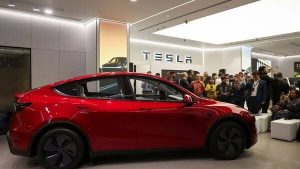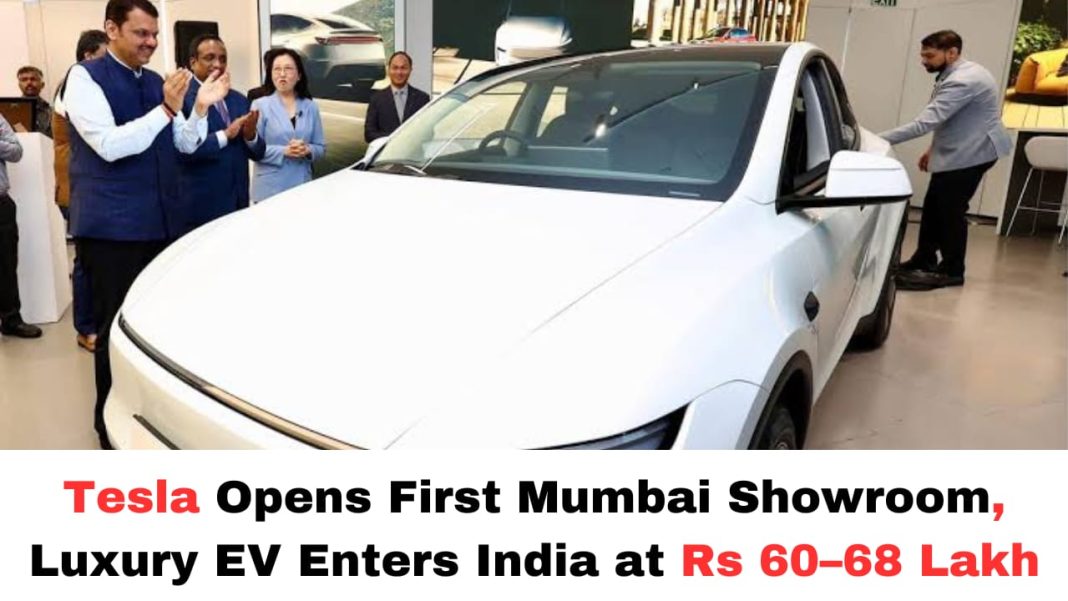Digital News Guru Automobile Desk:
Tesla’s Bold Entry into India
Tesla Inc. has officially entered India with a splash, inaugurating its first “experience centre” in Mumbai’s upscale Bandra Kurla Complex (BKC) and opening bookings for the long-awaited Model Y SUV. This landmark move marks the company’s arrival in the world’s third-largest auto market, setting it on a collision course with India’s complex import duty regime, nascent EV infrastructure, and fiercely elite competitive landscape.
Mumbai Experience Centre: A Milestone
Tesla’s India launch event came alive today, as Maharashtra Chief Minister Devendra Fadnavis joined executives to unveil the sleek new showroom at Maker Maxity Mall, BKC. The 4,000 sq ft space now hosts two China-made Model Y variants—Rear-Wheel Drive (RWD) and Long‑Range RWD—for public viewing and bookings. It also features Tesla’s V4 Supercharger concept, hinting at the company’s vision for its proprietary charging network across major urban hubs.

The inauguration marks a decade-long buildup since Tesla first teased India pre-orders in 2016. However, that enthusiasm was dashed by prohibitive tariffs and policy gridlock, prompting Musk to scratch the planned factory trip in 2024. Now, Tesla adopts an “import-first, test-the-market” strategy—seemingly cautious yet assertive .
Staggering Price Tags: A Premium Proposition
Tesla’s Model Y arrives in India with luxury tags: the standard RWD is set at Rs 59.89 lakh, while the Long‑Range variant climbs to Rs 67.89 lakh ex-showroom—on a par with Rs 60–68 lakh as widely reported. When taxes, registration, and insurance are added, costs cross Rs 70 lakh (~$70,000), roughly 50–70% higher than U.S. pricing, including federal credits.
These prices reflect India’s on-condition tariffs: 70–110% on completely built units (CBUs), though a reciprocal framework offers 15% tariffs for manufacturers committing to invest Rs 4,150 crore (~$500 million) and establish local production within three years. Tesla, at least initially, bypasses this route.
Performance, Range & Features
Though pricey, the Model Y delivers impressive specs. The standard RWD version offers ~500 km WLTP range with a 0–100 km/h sprint in 5.9 seconds; the Long‑Range variant pushes this to 622 km and 5.6 seconds, with a 201 km/h top speed. Tesla also highlighted its rapid Supercharger network—bolstering up to 267 km in 15 minutes—and optional Full Self‑Driving (FSD) software priced at Rs 6 lakh, though full regulatory approvals remain pending.
A Niche Yet Aspirational Market
India’s EV landscape is nascent. Battery EVs form roughly 2–4% of annual sales, with luxury electric vehicles a thin 1–4% slice of the overall market. Tesla’s pricing stakes it firmly in the luxury segment, targeting affluent urban buyers—those who might consider competing models like BMW iX1, Mercedes EQA (~49–67 lakh), Hyundai Ioniq 5 (46–66 lakh), and Kia EV6 (46–66 lakh).
Domestic challengers like Tata Harrier EV (19–21 lakh) or Mahindra BE 6e (~19.7 lakh) remain well below Tesla’s price band, appealing chiefly to budget-conscious consumers. Local EV leader BYD is also in play—though currently barred from Indian expansion due to regulatory red tape.

Charging Ahead: Infrastructure Strategy
Tesla is proceeding with caution but commitment. The company plans to establish eight Supercharger stations in Mumbai and four in Delhi, supported by destination chargers across major urban corridors. This mirrors Tesla’s global rollout model, anchoring the cars in an ecosystem that limits range anxiety and reinforces brand prestige.
Such infrastructure investment is crucial in India, where public charging remains fragmented and often unreliable. Tesla’s network may raise the bar for industry expectations.
Policy Quirks & Tariff Tensions
Tesla’s entry follows an intensive negotiation saga. Musk has reportedly lobbied hard against India’s 100% import duty structure, labeling it among the highest globally. A new policy has unlocked a tariff concession—15% on up to 8,000 EV imports annually—if local manufacturing is committed. Tesla has chosen to sidestep this, instead taking a risk by entering post-haste as a pure importer.
Beyond economic incentives, Tesla’s move may gain traction from trade deals. Recent Modi-Musk and India–U.S. discussions include tariff reduction as leverage, though global political complexity—like U.S. administrations—adds ambiguity .
The Road Ahead: Hitting the Accelerator or a Slow Drive?
Tesla’s India play hinges on several success factors:
- Demand reception: Will India’s ultra-expensive Teslas resonate with luxury buyers accustomed to brands like BMW and Mercedes?
- Policy evolution: Will India’s government incentivize manufacturing or maintain high import duties to protect domestic industry?
- Infrastructure execution: Can Tesla roll out its Supercharger network efficiently, and will India’s EV ecosystem keep pace?
- Regulatory permit: India’s infrastructure and traffic discipline may complicate Tesla’s autonomous driving ambitions—a key differentiator globally.

Analysts forecast Tesla may sell up to 50,000 cars annually by 2030 if the EV penetration rises to 10% and Tesla captures a 10% market share. That profit curve, however, depends on India rebalancing high import duties versus Tesla scaling production locally.
Summary
Tesla has officially entered India today, launching its first experience centre in Mumbai and opening bookings for the Model Y. It’s a premium, import-first strategy aimed at the luxury segment. Success will hinge on whether high-end buyers are ready to pay for imported EVs despite significant import duties. Substantive expansion—charging infrastructure, further showrooms, and eventual local production—will determine Tesla’s long-term foothold.
You May Also Read: Vidyut Jammwal Enters Hollywood Ring as Dhalsim in Street Fighter








